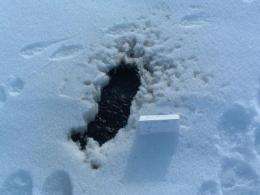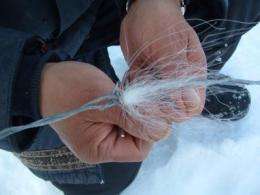New tracking approach will help protect polar bears

A new approach to tracking polar bears, developed by Queen's University researchers, will shed more light on the potentially endangered Arctic animal and help boost the economy of Canada's north.
Integrating the traditional knowledge of Inuit hunters with state-of-the-art genetic DNA analysis, a three-part method developed by biologists Peter V.C. de Groot and Peter Boag, is cheaper and much easier on the bears than the current tracking practice, in which they are spotted from helicopters, tranquilized and marked.

"The data from current aerial monitoring methods may be becoming less accurate with increased sea ice changes caused by global warming, and we need a more sensitive tool to monitor Canada's bear populations," says Dr. de Groot. "This [new] method, along with others being evaluated, should allow us to annually survey all of the country's polar bears, non-intrusively, with Inuit involvement, at a fraction of the current cost."
The Queen's researchers, including MSc Biology students Pamela Wong and Christopher Harris, are using a multi-phased approach to create a clearer picture of the polar bear population. First, a number of "hair traps" - fenced enclosures baited with meat - will be set up about 15 kilometres apart over a 600-kilometre area. Bits of hair left behind by the bears as they attempt to reach the meat are sent to Dr. Boag's lab, where the number and sex of the animals are determined using DNA markers. At the same time, samples of bear feces are collected and genetically screened by collaborators at the Laboratory of Wildlife Diseases at the San Diego Zoo for the presence of disease-causing agents that may infect polar bears.
Polar bear footprints provide the other two elements of Dr. de Groot's tracking method. As a testament to the strength of the Inuit ability to identify a bear's sex, age and size from its prints in the snow, some of the region's top hunters are allowing the reliability and accuracy of their diagnoses to be evaluated. The hunters' assessments, complemented by an analysis of digital images of the footprints, will be combined with the results of the genetic data to map the bear population's age and sex distribution, diet, movement and mating patterns.
The Queen's team has received up to $500,000 from the federal Ministry of Indian and Northern Affairs to refurbish and upgrade research cabins in the McClintock Channel, west of Baffin Island. Local labourers will be used to haul building materials hundreds of kilometres by skidoo, and set up the cabins. Coupled with ongoing polar bear surveys in which local residents set up the sampling stations and analyze tracks, this work is expected to provide an economic boost for the communities involved. And when the refurbished huts - each equipped with wind turbines, generators, heaters and 15 beds - aren't being used for research, Inuit hunters may be able to bring in eco-tourists by skidoo to observe the bears in a natural setting.
The funding is part of the federal government's integrated Northern Strategy that focuses on exercising Canada's Arctic sovereignty, protecting the North's environmental heritage, promoting social and economic development, and improving northern governance.
Source: Queen's University (news : web)













